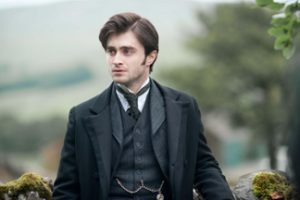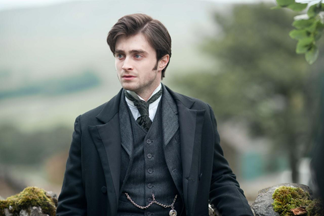By Joshua Knopp/managing editor
It might be prudent to include in The Woman in Black’s DVD features a sound byte of a frat-boy shouting “Use your patronus, Harry!” that plays at random points during the film. It’s definitely a big part of the theatrical experience.
The movie’s simple plot has Arthur Kipps (Daniel Radcliffe), a lawyer, sent to a small village in 1910s England to sort out the affairs of Alice Drablow, who has recently died. Many of Drablow’s documents are in her house, which is clearly haunted.

Photo courtesy CBS Films
The Woman in Black has impeccable focus. Even before the opening credits, the ghost is established, and three people are dead. After the credits, Kipps takes about 20 minutes to get to the haunted house, where he spends the next half-hour. Even in this interval, the film has a spectral pall over it. This is a ghost story, and in not a single frame is that forgotten.
The house is meticulously set up with details poured like a thick syrup over the set. Windows are placed such that even at midday, the shadows are broad and dark. Director James Watson uses shots down hallways, point-of-view shots from both Kipps and the ghost, mirrors and windows and clever shots into beady eyes of discarded dolls who reflect light from Kipps’ candle and appear to watch him walk by.
Radcliffe shines as Kipps. There may never again be an actor as indelibly linked to a role as he is to Harry Potter, but Radcliffe changes his body language completely. He carries long stretches of plot without dialogue and does so well. In all, it’s difficult to remember he was Potter so long without a willful attempt on the audience’s part.
The unerring focus of The Woman in Black results from its subtle script, which is at once slender and substantial. Dialogue is minimal, allowing the film to spend as much time as possible in quiet waiting for a scare. However, if one pays enough attention, details are layered such that they tell another story, a revenge drama that gives background to the specter.
The plot is so simplistic that, even at 95 minutes, the movie could be shorter. Some of the haunting sequences should have been cut off before they became silly. This would probably carve out a few scares, but the film wouldn’t lose its focus or become redundant. The movie isn’t exactly trailblazing. It pulls every trick within the book but none from without. Also, the wink at the audience is just bad.
The Woman in Black’s flaws only appear when under a microscope and are easily overlooked. This is a fantastic, throwback ghost story that blends jump scares with disturbing visuals and features a fantastic story and good acting.




























